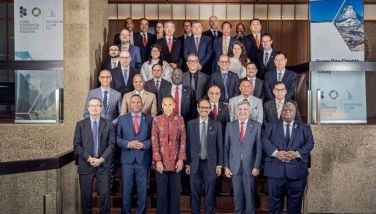The road ahead for Modi and India

Though his party didn’t win the landslide victory he hoped for, Prime Minister Narendra Modi has secured a rare third five-year term as India’s prime minister. It wasn’t an easy win. High inflation and unemployment helped a more unified opposition portray Modi as too cozy with big business to cut into the victory margin of his BJP-led alliance. The wealth inequality this has exacerbated forced Modi to lean more heavily on the appeal of an often-ugly Hindu Nationalism, a burden he has allowed subordinates to carry in the past. In addition, India’s media environment has become more polarized as many more people get their news online than when Modi was first elected a decade ago.
But Modi himself remains far more popular than his party. He has built a reputation for personal integrity, and after a decade in office, his name recognition is uncontestable. That matters in a country where dozens of different languages are spoken by millions of people. Once the votes were counted in the world’s largest and longest-running election, Modi emerged again as man of the moment.
India needs a popular leader, because the long-term challenges it faces are formidable. Within 10 years, India will face serious water shortages, and there is no obvious fix. He must work with weak local governments, many of which depend for political support on farming interests that rely too heavily on water-intensive agriculture in areas where water is already in short supply.
Then there is climate change. India has already set temperature records this summer, and hundreds of millions of Indians have no way to escape the heat and humidity. Add some of the world’s worst air quality, a problem that will become much worse given the country’s expected robust economic growth, and the enormous power requirements needed to sustain it, including with the use of huge amounts of coal generation. The result will be an expansion of human suffering in a nation with more than its share of environmental damage.
There is also a major structural problem with India’s economy: not many women contribute to it. Fewer than one third of employable women are now in the workforce. There are very few female CEOs or corporate board members, and a tiny fraction of the country’s venture capital funding goes to startups founded or led by women. The World Economic Forum’s most recent gender gap report ranked India 127 out of 146 countries, behind Bangladesh, Nepal and Sri Lanka. To solve this problem, Modi and other local officials must contend with a high rural population, crippling poverty and conservative social values. Many tout India’s strong demographics as a crucial economic advantage, particularly when compared with China, Japan and some of Europe’s largest economies, but when half the population faces such obstacles to joining the formal economy, the advantage is far from its potential.
Finally, India has 1.5 billion people, and too many still live in poverty. In 2023, India still ranked 111th of 125 countries on the Global Hunger Index. While China has become a middle-income country, India’s path toward that status is far from secure. Given all these structural challenges, India could fail to develop as Modi promises, leaving the country more vulnerable to social and political instability, fueled in part by the Hindu Nationalism that Modi himself has amplified.Yet, we can’t ignore the many advantages of India’s current geopolitical position. Modi’s government will continue to benefit from the trend that many Indians call “China +1.” That’s the popularity in both for Modi and India
Though his party didn’t win the landslide victory he hoped for, Prime Minister Narendra Modi has secured a rare third five-year term as India’s prime minister. It wasn’t an easy win. High inflation and unemployment helped a more unified opposition portray Modi as too cozy with big business to cut into the victory margin of his BJP-led alliance. The wealth inequality this has exacerbated forced Modi to lean more heavily on the appeal of an often-ugly Hindu Nationalism, a burden he has allowed subordinates to carry in the past. In addition, India’s media environment has become more polarized as many more people get their news online than when Modi was first elected a decade ago.
But Modi himself remains far more popular than his party. He has built a reputation for personal integrity, and after a decade in office, his name recognition is uncontestable. That matters in a country where dozens of different languages are spoken by millions of people. Once the votes were counted in the world’s largest and longest-running election, Modi emerged again as man of the moment.
India needs a popular leader, because the long-term challenges it faces are formidable. Within 10 years, India will face serious water shortages, and there is no obvious fix. He must work with weak local governments, many of which depend for political support on farming interests that rely too heavily on water-intensive agriculture in areas where water is already in short supply.
Then there is climate change. India has already set temperature records this summer, and hundreds of millions of Indians have no way to escape the heat and humidity. Add some of the world’s worst air quality, a problem that will become much worse given the country’s expected robust economic growth, and the enormous power requirements needed to sustain it, including with the use of huge amounts of coal generation. The result will be an expansion of human suffering in a nation with more than its share of environmental damage.
There is also a major structural problem with India’s economy: not many women contribute to it. Fewer than one third of employable women are now in the workforce. There are very few female CEOs or corporate board members, and a tiny fraction of the country’s venture capital funding goes to startups founded or led by women. The World Economic Forum’s most recent gender gap report ranked India 127 out of 146 countries, behind Bangladesh, Nepal and Sri Lanka. To solve this problem, Modi and other local officials must contend with a high rural population, crippling poverty and conservative social values. Many tout India’s strong demographics as a crucial economic advantage, particularly when compared with China, Japan and some of Europe’s largest economies, but when half the population faces such obstacles to joining the formal economy, the advantage is far from its potential.
Finally, India has 1.5 billion people, and too many still live in poverty. In 2023, India still ranked 111th of 125 countries on the Global Hunger Index. While China has become a middle-income country, India’s path toward that status is far from secure. Given all these structural challenges, India could fail to develop as Modi promises, leaving the country more vulnerable to social and political instability, fueled in part by the Hindu Nationalism that Modi himself has amplified.
Yet, we can’t ignore the many advantages of India’s current geopolitical position. Modi’s government will continue to benefit from the trend that many Indians call “China +1.” That’s the popularity in both Western and many Asian countries of limiting production and supply chain risks associated with China by shifting business operations and investment toward India. Many multinational corporations across a variety of key economic sectors now see India not only as a viable alternative for long-term capital investment, but as an attractive market in its own right.
India’s domestic infrastructure investment continues to lag behind China, but the gap is narrowing. In Mumbai, major new highways, bridges and tunnels are easing some of the world’s worst urban traffic. There are fewer interruptions of electricity, data and the internet. India is not China, but its day-to-day business operations are no longer regularly disrupted. India has also made gains in higher-end manufacturing, with the export of more motorcycles, cars and other goods that meet an international quality standard once unknown in India.
India’s biggest foreign-policy challenges are on its borders – in China, Pakistan and Myanmar. All three create security problems for Delhi. But outside India’s neighborhood, Modi looks abroad and sees important opportunities. That’s true not only in relations with the United States – India is one of the few countries that can expect increasingly close ties with Washington no matter who wins the November US election – but especially in the Global South, where Modi has earned a leadership role. As we saw last year when India hosted the G20 summit, Modi wants India to become a vitally important bridge between the developed and developing worlds. Since the Cold War’s end, no country’s rise has been welcomed by so many other governments.
In short, India still faces enormous long-term challenges. But Narendra Modi’s personal appeal at home and the inroads he has helped open for India abroad make this country’s development one of the most important stories of the next decade.Though his party didn’t win the landslide victory he hoped for, Prime Minister Narendra Modi has secured a rare third five-year term as India’s prime minister. It wasn’t an easy win. High inflation and unemployment helped a more unified opposition portray Modi as too cozy with big business to cut into the victory margin of his BJP-led alliance. The wealth inequality this has exacerbated forced Modi to lean more heavily on the appeal of an often-ugly Hindu Nationalism, a burden he has allowed subordinates to carry in the past. In addition, India’s media environment has become more polarized as many more people get their news online than when Modi was first elected a decade ago.
But Modi himself remains far more popular than his party. He has built a reputation for personal integrity, and after a decade in office, his name recognition is uncontestable. That matters in a country where dozens of different languages are spoken by millions of people. Once the votes were counted in the world’s largest and longest-running election, Modi emerged again as man of the moment.
India needs a popular leader, because the long-term challenges it faces are formidable. Within 10 years, India will face serious water shortages, and there is no obvious fix. He must work with weak local governments, many of which depend for political support on farming interests that rely too heavily on water-intensive agriculture in areas where water is already in short supply.
Then there is climate change. India has already set temperature records this summer, and hundreds of millions of Indians have no way to escape the heat and humidity. Add some of the world’s worst air quality, a problem that will become much worse given the country’s expected robust economic growth, and the enormous power requirements needed to sustain it, including with the use of huge amounts of coal generation. The result will be an expansion of human suffering in a nation with more than its share of environmental damage.
There is also a major structural problem with India’s economy: not many women contribute to it. Fewer than one third of employable women are now in the workforce. There are very few female CEOs or corporate board members, and a tiny fraction of the country’s venture capital funding goes to startups founded or led by women. The World Economic Forum’s most recent gender gap report ranked India 127 out of 146 countries, behind Bangladesh, Nepal and Sri Lanka. To solve this problem, Modi and other local officials must contend with a high rural population, crippling poverty and conservative social values. Many tout India’s strong demographics as a crucial economic advantage, particularly when compared with China, Japan and some of Europe’s largest economies, but when half the population faces such obstacles to joining the formal economy, the advantage is far from its potential.
Finally, India has 1.5 billion people, and too many still live in poverty. In 2023, India still ranked 111th of 125 countries on the Global Hunger Index. While China has become a middle-income country, India’s path toward that status is far from secure. Given all these structural challenges, India could fail to develop as Modi promises, leaving the country more vulnerable to social and political instability, fueled in part by the Hindu Nationalism that Modi himself has amplified.
Yet, we can’t ignore the many advantages of India’s current geopolitical position. Modi’s government will continue to benefit from the trend that many Indians call “China +1.” That’s the popularity in both Western and many Asian countries of limiting production and supply chain risks associated with China by shifting business operations and investment toward India. Many multinational corporations across a variety of key economic sectors now see India not only as a viable alternative for long-term capital investment, but as an attractive market in its own right.
India’s domestic infrastructure investment continues to lag behind China, but the gap is narrowing. In Mumbai, major new highways, bridges and tunnels are easing some of the world’s worst urban traffic. There are fewer interruptions of electricity, data and the internet. India is not China, but its day-to-day business operations are no longer regularly disrupted. India has also made gains in higher-end manufacturing, with the export of more motorcycles, cars and other goods that meet an international quality standard once unknown in India.
India’s biggest foreign-policy challenges are on its borders – in China, Pakistan and Myanmar. All three create security problems for Delhi. But outside India’s neighborhood, Modi looks abroad and sees important opportunities. That’s true not only in relations with the United States – India is one of the few countries that can expect increasingly close ties with Washington no matter who wins the November US election – but especially in the Global South, where Modi has earned a leadership role. As we saw last year when India hosted the G20 summit, Modi wants India to become a vitally important bridge between the developed and developing worlds. Since the Cold War’s end, no country’s rise has been welcomed by so many other governments.
In short, India still faces enormous long-term challenges. But Narendra Modi’s personal appeal at home and the inroads he has helped open for India abroad make this country’s development one of the most important stories of the next decade.
- Latest
- Trending






























